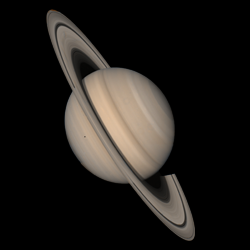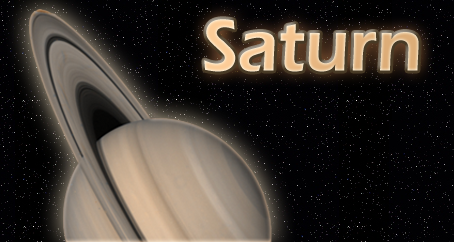Welcome to Saturn

Saturn is quite often regarded as one of the most beautiful and outstanding objects in the Solar System. It is a gigantic planet with huge rings surrounding it, and a moon which resembles an early Earth! Saturn is named after the Roman god of agriculture and vegetation. However, there is no actual land on Saturn for the planet to possess any agriculture or vegetation. The entire planet, like Jupiter, is made up of gas! It may have a liquid core, caused by immense pressure weighing heavily at the centre and squeezing molecules together into a liquid state, rather than a 'gassy' state, but most of the planet is one gigantic sky!
The planet spins on its axis so fast that, instead of appearing round, it is more oval shaped, being wider across its centre than from top or bottom. In fact, its widest point (not including its rings) is 120,000 kilometres. Its narrowest point (from the North to the South Pole) is 100,000 kilometres! Saturn, despite being able to contain hundreds of Earths, is only 95 times as heavy as Earth. This is because it is mainly gas. If the gas was squeezed together to form a solid, the planet may be a similar size to Earth.
What makes Saturn so different from the other planets in the Solar System, and what makes it the most attractive, is its amazing rings. It has been discovered recently that all of the four outer planets (Jupiter, Saturn, Uranus and Neptune) have ring systems, although only Saturn's is easily noticeable through a telescope from Earth. Below is a picture of Saturn taken from a telescope on Earth. From it you can see how easily visible Saturn's rings are.

Saturn's secrets were finally revealed in 1980 when the two Voyager spacecrafts visited the planet after Jupiter. They took pictures of the Gas Giants and their moons. They also allowed us to see what Saturn's rings looked like close up and let us decide how they were made. We also discovered information about Titan, the second largest moon in the Solar System (after Ganymede, one of Jupiter's moons) and found that it is the only moon with a thick atmosphere, containing some of the chemicals necessary for life! A space craft called Cassini-Huygens was launched in October 1997 to orbit Saturn to take more pictures and to observe Titan. Titan's thick atmosphere means that it was impossible to see its surface in 1980 by Voyager, but equipment on Cassini-Huygens was able to see through the clouds. A small probe also descending from the space craft and landed on Titan's surface and send back images from the moon itself.
